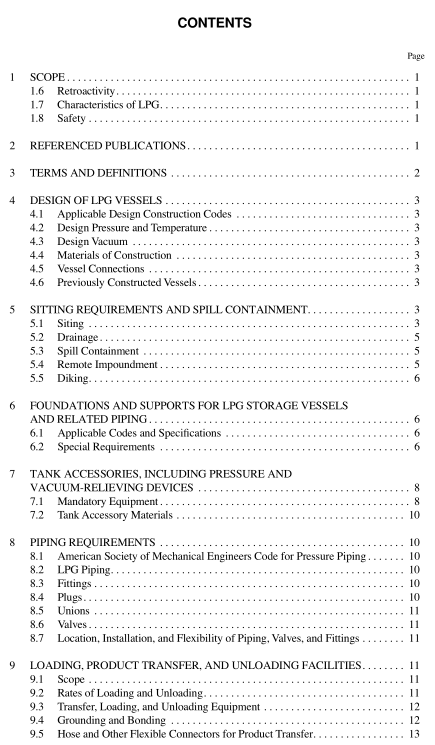API std 2510 pdf download

API std 2510 pdf download Fabrication Considerations for Vanadium-Modifed Cr-Mo Steel Heavy Wall Pressure Vessels
A more likely LPG incident, and in the context of this pub-lication a more relevant one, is leakage from piping or othercomponents attached to or near the vessel followed by igni-tion, a flash fire or vapor cloud explosion,and a continuingpool fire and pressure (torch) fire.
5.1.1.2With the exception of spacing, the design featuresdiscussed in this standard are intended to prevent a majorincident. Spacing is intended to minimize both the potentialfor small leak ignition and the exposure risk presented toadjacent vessels,equipment,or installations in case ignitionoccurs. Spacing is not intended to provide protection from amajor incident.
5.1.1.3Safety analysis and dispersion modeling are usefultools in estimating setback distances to limit the exposure riskto adjacent facilities.
5.1.2 Minimum Distance Requirement
5.1.2.1 The minimum horizontal distance between theshell of a pressurized LPG tank and the line of adjoiningproperty that may be developed shall be as shown in Table 1.Where residlences, public buildings, places of assembly, orindustrial sites are located on adjacent property,greater dis-tances or other supplemental protection shall be provided.5.1.2.2The minimum horizontal distance between theshells of pressurized LPG tanks or between the shell of apressurized LPG tank and the shell of any other pressurizedhazardous or flammable storage tank shall be as follows:a. Between two spheres,between two vertical vessels,orbetween a sphere and a vertical vessel, 5 ft or half of thediameter of the larger vessel, whichever is greater.
b. Between two horizontal vessels,or between a horizontalvessel and a sphere or vertical vessel, 5 ft or three quarters ofthe diameter of the larger vessel, whichever is greater.
5.1.2.3 The minimum horizontal distance between theshell of a pressurized LPG tank and the shell of any othernonpressurized hazardous or flammable storage tank shall bethe largest of the following with the exception noted afterltem d:
a. If the other storage is refrigerated, three quarters of thegreater diameter.
b. If the other storage is in atmospheric tanks and is designedto contain material with a flash point of 100°F or less,onediameter of the larger tank.
c. If the other storage is in atmospheric tanks and is designedto contain material with a flash point greater than 100 F, halfthe diameter of the larger tank.
d. 100 ft.
The minimum horizontal distance between shells need notexceed 200 ft.
5.1.2.4The minimum horizontal distance between theshell of an LPG tank and a regularly occupied building shallbe as follows:
a. If the building is used for the control of the storage facility,50 ft.
b. If the building is used solely for other purposes (unrelatedto control of the storage facility), 100 ft.
c. Compliance with API 752 may be used in lieu of therequirements in paragraph a and b.
5.1.2.5 The minimum horizontal distance between theshell of an LPG tank and facilities or equipment not coveredin 5.1.2.1 through 5.1.2.4 shall be as follows:
a. For process vessels, 50 ft.
b. For flares or other equipment containing exposed flames,100 ft.
c. For other fired equipment, including process furnaces andutility boilers, 50 ft.
d. For rotating equipment,50 ft; except for pumps takingsuction from the LPG tanks,10 ft.
e. For overhead power transmission lines and electric substa-tions, 50 ft. In addition, siting shall be such that a break in theoverhead lines shall not cause the exposed ends to fall on anyvessel or equipment.
f. For loading and unloading facilities for trucks and railcars,50 ft.
g. For navigable waterways, docks, and piers,100 ft.h. For stationary internal combustion engines, 50 ft.
5.1.2.6The minimum horizontal distance between the shellof an LPG tank and the edge of a spill containment area forflammable or combustible liquid storage tanks shall be 10 ft.Note: If the spill containment is by the use of dikes or walls. the edgeof the spill containment area for the purpose of spacing is defined asthe centerline of the dike or wall. If the spill containment is by slop-ing, grading, or channels, the edge of the spill containment area forthe purpose of spacing is dcfined as the outer edge of the wetted areaat the design incident for the spill containment facility.









